The Economics and Statistics Division maintains archives of previous publications for accountability purposes, but makes no updates to keep these documents current with the latest data revisions from Statistics Canada. As a result, information in older documents may not be accurate. Please exercise caution when referring to older documents. For the latest information and historical data, please contact the individual listed to the right.
<--- Return to Archive
For additional information relating to this article, please contact:
February 05, 2021LABOUR FORCE SURVEY: VISIBLE MINORITIES, JANUARY 2021 Starting with July 2020, Statistics Canada has added a question to the Labour Force Survey asking respondents about whether they identify with visible minority populations. The population group categories of response are the same as those found in the 2016 Census: White, South Asian (e.g., East Indian, Pakistani, Sri Lankan), Chinese, Black, Filipino, Arab, Latin American, Southeast Asian (e.g., Vietnamese, Cambodian, Laotian, Thai), West Asian (e.g., Iranian, Afghan), Korean, Other.
Labour force characteristics for Aboriginal populations are reported separately in the Labour Force Survey.
This analysis will focus on conditions reported by respondents for January 2021. Results are not seasonally adjusted. Unless otherwise indicated, data refer to populations aged 15-69.
The results for January 2021 continue to show that respondents who identify with a visible minority population had higher unemployment rates (12.0%) than those who do not identify as Aboriginal or a visible minority (8.9%).
Most regions reported substantially higher unemployment rates for those who identify with a visible minority group. The gap in unemployment rates was smaller in Atlantic Canada: populations that identify with a visible minority have an unemployment rate (11.8%) one percentage point higher than those that do not identify as Aboriginal or a visible minority (though this data is of limited quality). This gap is notably larger in Quebec, where those that identify with a visible minority have an unemployment rate of 15.0% while those who do not dentify as Aboriginal or a visible minority have an unemployment rate of 8.3%.

In Ontario, participation rates in the labour force were lower for visible minority populations than for those who do not identify as Aboriginal or visible minority. Participation rates were higher for visible minority populations in all other regions, especially Atlantic Canada when compared against those who do not identify as Aboriginal or visible minority.
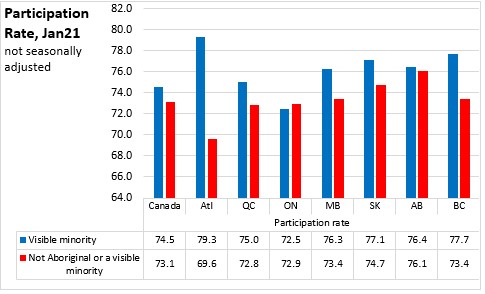
The gap between employment rates of visible minorities (65.6%) and those who do not identify as aboriginal or a visible minority (66.6%) is largely explained by higher unemployment rates instead of lower participation rates. The largest gaps were observed in Quebec and Ontario. The gaps were reversed with notably higher employment rates for those that identify with visible minority populations in Atlantic Canada and British Columbia.
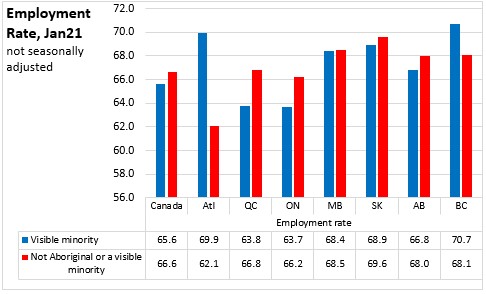
Unemployment rates were higher across almost all visible minority populations than for those who did not identify as Aboriginal or in a visible minority population. (Some of these results have limited data quality and should be used with caution).
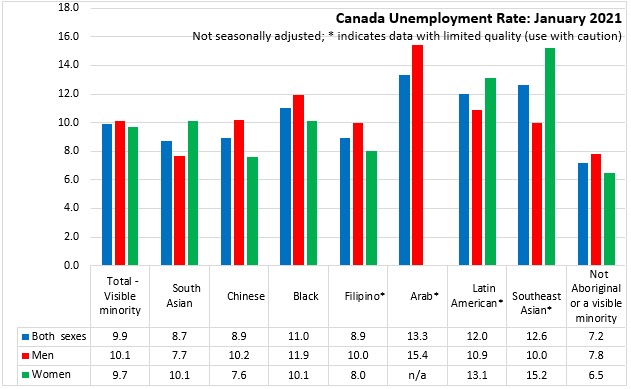
Labour force participation rates were higher among men than women across all population groups. The differences were somewhat wider among some visible minority populations.
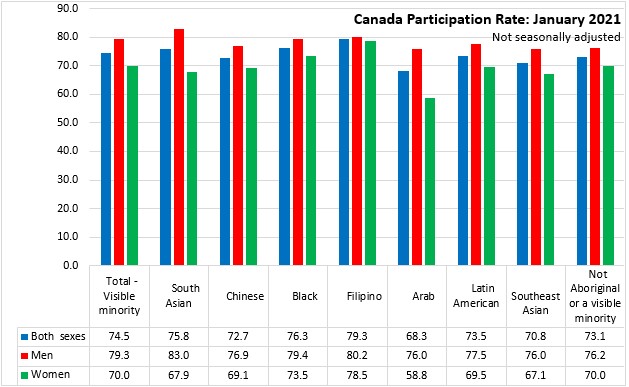
With gaps in both participation and unemployment rates, women in many visible minority populations had notably lower employment rates than men. The exception is among those who identify as Filipino, where higher participation rates elevate employment rates among women. Women who are not in Aboriginal or visible minority populations also had lower employment rates than males.
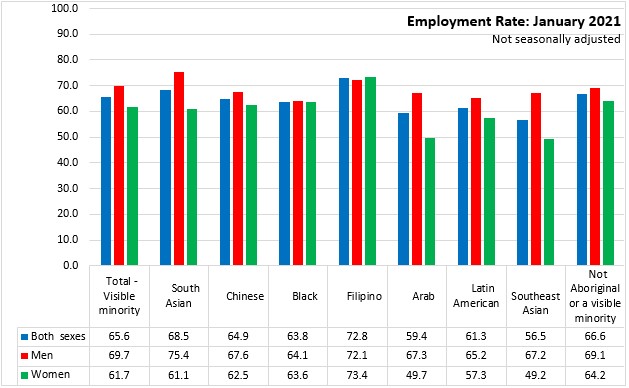
Unemployment rates are higher for all age cohorts of visible minority populations.
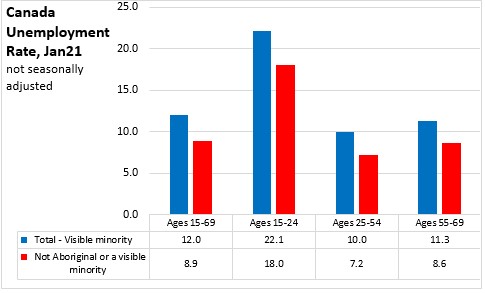
Participation rates of visible minority populations are higher for older workers, compared to the same age cohort that does not identify as Aboriginal or visible minority populations. Among youth and core aged workers, participation rates among visible minority populations are lower than among similarly-aged populations that do not identify as aboriginal or a visible minority.

With lower participation and higher unemployment rates, employment rates are lower for visible minority youth and core aged populations. With stronger participation rates (and despite higher unemployment rates), the employment rate of older visible minority populations is higher than among older Canadians who do not identify as Aboriginal or a visible minority.

Source: Statistics Canada, Labour Force Survey, January 2021
<--- Return to Archive